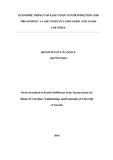| dc.description.abstract | Kenya has a vibrant small-scale based dairy industry that plays an important economic and nutrition role in the lives of many people, ranging from farmers to petty milk traders ("hawkers"), processors, and consumers. However, the high incidence of tick-borne livestock diseases in Kenya is a major challenge to the dairy industry in the country. East Coast Fever (ECF) is one of these diseases, and the ECF Infection and Treatment Method (ECFIM) is one of the novel strategies that are being promoted to control ECF in Kenya. Various socioeconomic impact studies on ECF carried out by several scholars showed that immunization of beef cattle under farm conditions was profitable. However, no recent socioeconomic study of the ECFIM vaccine had been carried out to account for the changing social and economic environment. This study sought to fill the gap by examining socioeconomic aspects of ECFIM vaccine in high potential, dairy producing areas. The study evaluated the Knowledge, Attitude, Perception and Practices (KAPP) with regard to ECF and economic impact of ECF and ECF control by use of Infect and Treat Method in high potential dairy producing areas of Kenya. A cross sectional study of a sample of 330 randomly selected households from Nandi and Uasin Gishu counties shows that the mortality and cost of treatment were the most significant economic losses due to ECF diseases with a P-value of 0.005 and < 0.001 respectively. Regarding the KAPP, only 24.5 % of the respondents were able to correctly identify ECF symptoms. Households whose head had university education level and above were 2.44 times more likely to adopt ECF vaccine compared to those who had no formal education. ECF-vaccinating households realized an overall net economic return of Kshs 44,575 (about US$ 450) per cow per year while the ECF non-vaccinating households realized a net loss of Kshs 9,975 (about US$ 100) per cow per year. | en_US |



